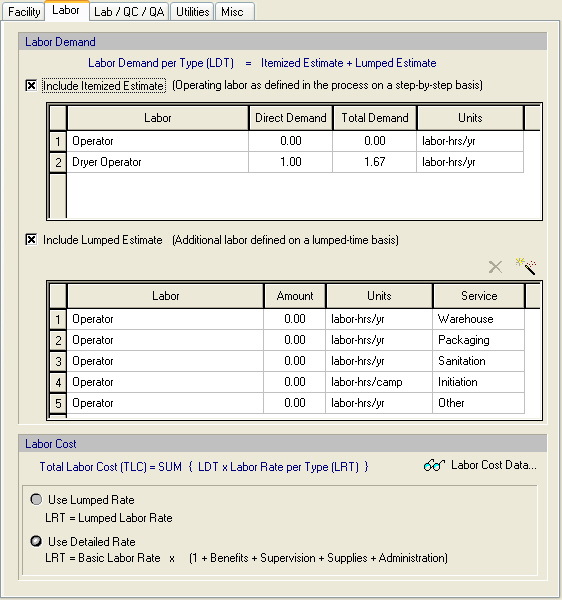

This tab is part of the ‘Operating Cost Adjustments’ dialog of a process section; for more details, see Operating Cost Adjustments Dialog.
The following table shows a brief description of the variables appearing in this tab. The table also displays their default values and their generally acceptable range:
|
Variable |
Default Value |
Range |
|
|
||
|
○ Include Itemized Estimate |
Yes |
Yes/No |
|
● Direct Demand (labor-hrs/yr) |
0.0 |
Positive |
|
● Total Demand (labor-hrs/yr) |
0.0 |
Positive |
|
○ Include Lumped Estimate |
Yes |
Yes/No |
|
○ Labor |
Operator |
Any Text |
|
○ Amount (labor-hrs/yr) |
1.0 |
Positive |
|
○ Service |
Undefined |
Any Text |
Symbol Key: ○ User-specified value (always input); ● Calculated value (always output); ◙ Sometimes input, sometimes output
The following list describes the available specification choices in this tab; for more details on how these are implemented, see Labor-Dependent Cost.
•‘Include Itemized Estimate’ option...
If this option is checked, the calculation of a section’s LDT will include an itemized estimate of LDT for that section. This is calculated for each labor type as the sum of individual labor demands (based on total demand) by all operations of that section. By default, this option is checked.
•‘Include Lumped Estimate’ option...
If this option is checked, the calculation of a section’s LDT will include a lumped estimate of LDT for that section. For each labor type, this is calculated based on all labor amounts listed in the available table. In this table, each row corresponds to a dedicated labor type or service. By default, this table is initialized with five rows dedicated to five different services of the ‘Operator’ labor type (warehouse, packaging, sanitation, initiation, and other). To add a row to the table, click Create/Add New ( ). To delete a row from the table, click on the row number and then click Delete (
). To delete a row from the table, click on the row number and then click Delete ( ). For each added row, you can specify a dedicated labor type or service and a corresponding labor amount. By default, this option is checked but all listed labor amounts are zero (resulting in zero lumped LDT).
). For each added row, you can specify a dedicated labor type or service and a corresponding labor amount. By default, this option is checked but all listed labor amounts are zero (resulting in zero lumped LDT).
•Labor Cost Options...
You may select among two different options for the calculation of the labor cost rate per type (LRT) (in $/labor-hour):
a) Use Lumped Rate
b) Use Detailed Rate
If the first option is selected, the lumped rate is used as the labor cost rate for each labor type. If the second option is selected, a detailed rate is calculated for each labor type based on the specified basic rate and adjustment factors (benefits factor, operating supplies factor, supervision factor, administration factor) for that labor type. This information can be viewed by clicking the Labor Cost Data ( ) button. By default, LRT is calculated based on the second option.
) button. By default, LRT is calculated based on the second option.
For information on the section labor cost dialogs please see:
● Section Labor Cost (Based on Lumped Rate) Dialog
● Section Labor Cost (Based on Detailed Rate) Dialog
See also: